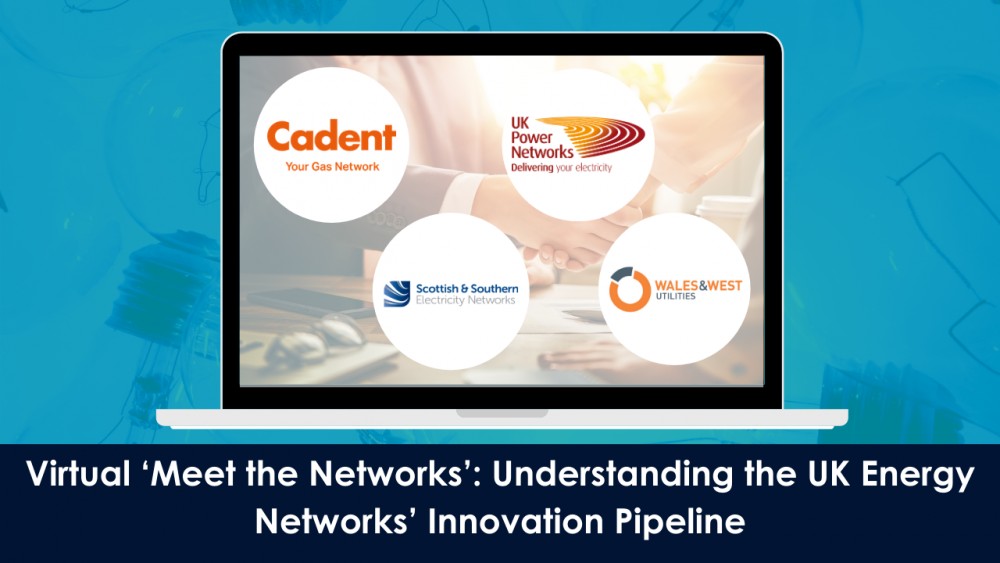Akshay Kaul is the Director of Systems and Networks at Ofgem. He joined the regulatory body 18 months ago and spent his first year working on projects with their offshore transmission network. Now, Akshay is at the forefront of pricing controls for the UK’s onshore gas and electricity networks. In an interview with the EIC’s Innovation Community Lead, Liam Bolton, he discusses the upcoming RIIO-2 framework, the challenges facing today’s energy networks, and shares invaluable advice for those hoping to innovate within the sector.
Q. How important is the energy sector to the wider UK economy in terms of jobs and GVA?
The energy sector is the fundamental underpinning of most economic activity in the country. If the electricity or gas system fails or if there are supply interruptions, the economic consequences of that for customers can be absolutely catastrophic and that’s why I’m really pleased that the GB energy system, whether it’s gas or electricity, is one of the most reliable systems in the world in terms of the number of the jobs it creates but also, more importantly, the amount of economic activity that it supports. Overall, the energy sector is probably the most crucial sector of the UK economy.
Q. In terms of emerging trends within the sector, what do you consider to be some of the key areas moving forward?
From my point of view, I see three big forces that are going to completely reshape the industry- the three Ds. The first is the ongoing decarbonisation of the sector which will lead to huge changes in the next 10 to 15 years, creating enormous opportunities both for SMEs and large network companies. The second big force of change is the decentralisation of energy. Whilst energy was once provided solely from large power stations or gas shippers, all the way down to the household through a one-way flow of energy, we are now seeing a much greater diversity of energy sources being put into place at a more local level. Energy flows are also increasingly moving two ways. Not only are we seeing energy move from the transmission system to the distribution system, we are also beginning to see a balancing of the energy flow as local power generated by households, through their solar panels, flows back into the transmission system. The third and final force is the increasing digitalisation of the energy sector. A lot of things that used to be run on analogue technology are moving to having automated, digital controls. This brings with it risks; as it is becoming a more open environment, people may find it easier to exploit vulnerabilities that were more difficult within an analogue environment. However, digitalisation provides huge opportunities to drive value for consumers.
Q. Could you explain the role of Ofgem as a regulator and how the relationship between Ofgem and the networks functions?
Ofgem is the economic regulator in Great Britain for the energy system - both gas and electricity. This means essentially two things; we license network providers, establishing legal and statutory underpinnings and making sure that they’re fit for purpose, and we implement price controls on the gas and the electricity networks to ensure that they don’t exploit their monopoly position to overcharge customers. We also regulate energy supply in terms of retailers providing services to households. This has included, more recently, the introduction of a retail price cap on standard variable tariffs. Within the wholesale market, our main responsibilities are to ensure that the market is working competitively, that there are no barriers to entry for new providers, that market price signals are efficient and effective, and that the trading rules are operating in the best interests of consumers.
Q. Can you tell us a bit about the RIIO-2 framework and what that entails?
RIIO is our name for the framework of network price regulation that we introduced in 2013. It used to be called RPM-X, which was easier to describe because the price cap was very simple - it was set so that prices would rise by the retail price index, less the x factor, which was our best guess of how efficient the networks could be. After around 20 to 25 years of operating that system, we felt that there was a need for a change and reformed it into this new framework called RIIO. RIIO stands, not for the Brazilian city of joy, but for the fact that the revenues of the network utilities are set to deliver innovation through incentives and outputs.
One thing I’d really like to highlight is the output oriented nature of the price control. We say to companies, “Go and talk to your customers. Go and find out what they want and we will frame those as outputs that you need to deliver. How you choose to deliver them is up to you.” If you can be more efficient, that’s really good because we capture the benefits of that for consumers but it is very output oriented. The other thing I’d like to mention is the innovation aspect of this. Traditional price controls didn’t have such a focus on innovation, but for the last ten or so years in Ofgem we have deliberately placed an explicit focus on encouraging innovation in the regulated utility industry. We’ve done so through a range of mechanisms including, having incentives on networks to improve service quality and reduce costs, design of the price control and providing network funding that encourages collaboration with SMEs and the testing of new ideas and technologies.
A key requirement of RIIO-2 is for it to respond to the three forces of change that I talked about earlier- the three Ds. The future is not going to be like the past; it’s going to be very different from the past and that’s a crucial thing for a price control to recognise. I don’t want to overstate the importance of the price control in terms of it being a driver of change in the system, because it is not. The change is going to happen anyway and it’s going to happen throughout the networks. However, we are very keen for the networks that we regulate to be positive enablers of that change and supporters of new technology and disruptions that come in from the outside. It is in the interest of consumers that the networks work with these changes, rather than be blockers of them. It is due to this that we would like to design a set of price controls for RIIO-2 that allow networks to play this role in full and help us move towards a dynamic, decentralised, low carbon, digital energy system.
We also aim to target big R&D challenges and come up with good innovation in response to them. We want to ensure that neither we nor the networks work in silos. Increasingly these are cross-sector and cross-vector challenges that require a lot of collaboration across different parties and we certainly anticipate a need to work very closely with government, particularly with regards to innovation funding within the government, academia and the industry. Connecting these different sources of innovation funding, so that they work much better together, is the second big priority for us in RIIO-2.
Q. How is the framework shaping up?
Things are going pretty well. We started out in July of last year with an open letter inviting comments and thoughts from anybody who’s interested in the network space, on which big themes should shape the next round of price controls. We then launched a consultation on the general framework for the price controls in March of 2018. We made the decisions in July and concluded that we would have a shorter price control, maintain the innovation stimulus and the output oriented nature of the programme, and that we would also bring in some controls in terms of the overall returns that network companies make from these price controls.
We are now looking forward to launching the next round of consultations for each of the sectors, in December. This includes, tackling particular challenges in gas distribution, gas and electricity transmission, and settling on the methodology for price controlling in these three sectors. Further to this, we are asking that companies talk to their customers and users in order to draw up spending plans, which are to be fed back to Ofgem by 2020. We then plan to assess these and open up public hearings, where anybody who’s interested can come along and take a look at them and either offer up challenges or support. It will then be towards the end of 2020 that we will set the final price controls that start operating thereafter.
Q. Could you tell us about NIA (Network Innovation Allowance) and NIC (Network Innovation Competition)?
The innovation programme in RIIO-1 essentially takes shape in terms of three components. The first component is a Network Innovation Competition where networks, together with third party partners, are able to make bids for new R&D projects that they think will help us with the energy transition. We have a panel that evaluates the bids, selects the most promising ones and then provides a dedicated pot of funding for that innovation project. The second component is the Network Innovation Allowance. This is an allowance that we give to network companies. They don’t have to bid for it; it’s just part of their revenue settlement. 75 percent of that allowance is meant to be spent on working with other providers, rather than on their own business, which includes SMEs and other third parties. The third element is what we call the innovation rollout mechanism. This mechanism is meant to help us ensure that, when we find successful innovations, there is a way of diffusing them across the sector, through collaboration between different networks.
We are still undecided on whether we need to retain exactly the same three components heading into RIIO-2. We are really keen on making sure that innovation funding is directly addressing the main energy transition challenges, and that these are not difficult to spot. This focuses, once again, on those three forces; decarbonisation, decentralisation and digitalisation. One way in which they take shape is in the anticipated deployment of electric vehicles and the demands that they will put on the network. We want to see a lot of innovation in that space, as building new pipes and wires is going to be less the right solution to that kind of demand, with smart technology more than likely taking its place.
We want to see a lot more innovation in terms of particular challenges on electric vehicles. For example there will be many R&D challenges in the use of hydrogen. It’s a new kind of gas and we have to think about how it is produced and transported through the networks. Therefore, there’s certainly a fair amount of innovation to be done in terms of making the networks safe in transporting hydrogen, as a fuel, around the country. There will also continue to be a need for great innovation in digitalisation and the big challenge in terms of active demand management locally, both in helping the network providers balance their local system and facilitating the penetration of new technologies from the providers of technologies, such as vehicle to grid charging.
Q. What role does Ofgem see SMEs playing in the next price control?
We are very positive about the role that SMEs can play, in particular start-ups, inventors, disruptors and people coming in with new ideas. The sector has been dominated for a while by incumbents and a fairly traditional way of doing things in regards to how energy is transported across the country. SMEs have a huge role to play in the future, both in terms of gas and electricity, as there are set to be big changes in the business models surrounding the transportation and delivery of energy to households. I think SMEs can be at the cutting edge of most of these changes. Whether it is through accommodating the increased take-up of electric vehicles; supporting the transition from high carbon gas to low carbon gas or tackling the question of how we can create low carbon heating for households, we really do see SMEs being at the forefront of this revolution.
Q. What does Ofgem consider success to look like for SMEs?
SMEs coming up with business ideas that get adopted is the basic criterion for success. Obviously, not every idea will make it through to successful implementation. However, we do recognise the value of trial and error, and are keen to experiment with different approaches, ideas and technologies, and we’re expecting to see that some of them will succeed and some of them will fail. With those that do succeed, we think it would be great if SMEs were able to find a way of diffusing that success and prompting a largescale adoption of these technologies on a commercial basis across the system, particularly on the network side. It is for precisely this reason that we require the networks to spend more than 75 percent of their innovation allowance outside the business, as we want them to engage with SMEs, find ideas that work, and then share those ideas across the system.
Q. How will Ofgem continue to engage and support innovators in the sector?
We are very keen to engage and support innovators on all aspects of the energy system. As mentioned previously, we have programmes that are specifically designed for the network sector because we think there are price controls there that probably mean that, in the absence of the stimulus, we wouldn’t get the same level of R&D spending and innovation from network utilities. We provide about £400 million of innovation funding to network companies precisely for them to go and work with SMEs and try out new R&D ideas, which I think creates a big source of opportunity for SMEs.
In addition to this, SMEs should pay a lot of attention to the innovation programmes that Ofgem runs to encourage third parties to come into the sector. We have an innovation link programme where mentors can come in and talk to us about new ideas and to see what advice might be on offer in terms of the regulatory arrangements. We also run sandboxes, where people are able to try out ideas in a relatively safe, regulatory setting.
We really want to expand the role of third parties, particularly SMEs, as we are increasingly finding that the best ideas are going to come from outside the network space by people who are sitting in their garages and thinking up new ideas. We want the networks to be big facilitators of this in terms of how they engage with them, and to also create efficient and effective ways for third parties to engage directly with the system. It is due to this that I want to emphasize the different ways in which Ofgem, as a regulator, and the networks, as providers of network services, establish forums available to SMEs in order for them to engage with us. I’d really like SMEs to come and talk to Ofgem and tell us how we can make our network innovation programmes more accessible to SMEs and third parties.
Q. What advice would you give to those hoping to innovate within the sector?
It’s good to have good ideas. It’s good to have big ideas. I would advise starting with the consumer experience in mind. Think about the ways in which the supply and consumption of energy could be made more reliable and cost effective for them in this changing environment. SMEs should think about the sort of technological segments in which they have their core competencies, because when you’re trying to get into this sector, particularly the network sector, we think it is important to have ideas that are implementable within the context of an energy network, and working with network companies is a clearly big part of that.









